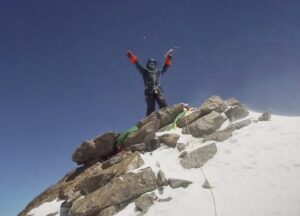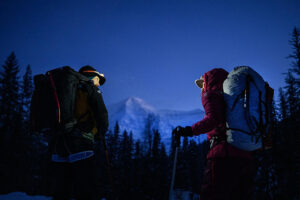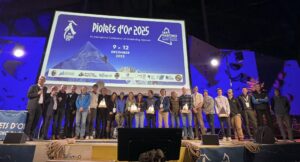Every spring for over a century, the American Alpine Club has announced the American expeditions they will support with a Cutting Edge Grant. The grant supports pure alpine-style projects to difficult, remote mountains.
This year sees action on five peaks: Shivling, Yashkuk Sar, Jannu East, Ultar Sar, and Chiling II. This series looks at the climbing history of each peak. We have already written about Shivling, Yashkuk Sar, and Jannu East. Today, we continue with Ultar Sar.
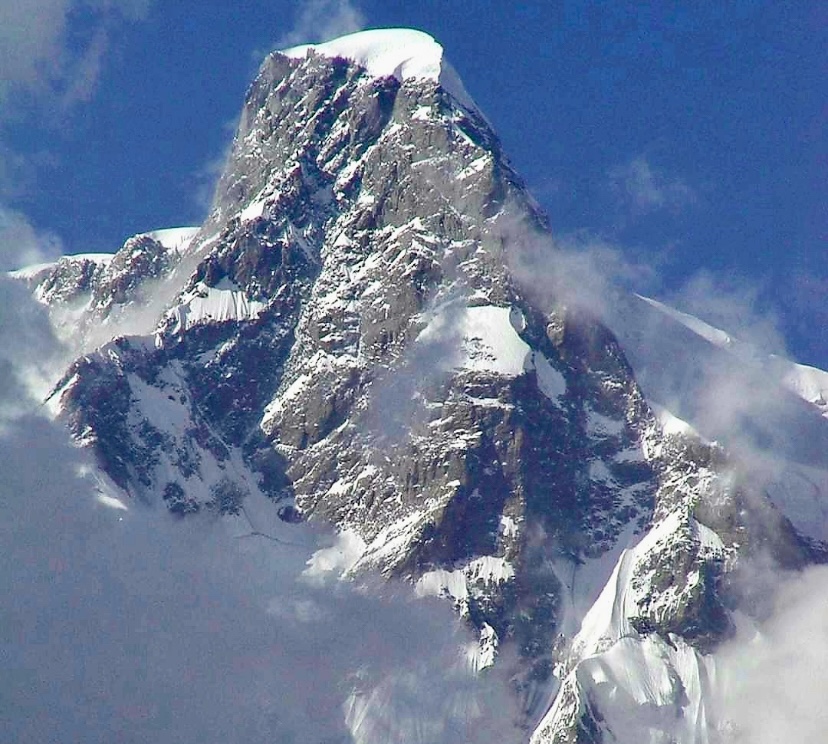
Ultar Sar. Photo: Alpine Adventure Guides
The Ultar peaks
Ultar Sar, 7,388m, is also known as Bojohagur Duan Asir II, Ultar, or Ultar II. It lies in the Batura Muztagh range, at the western end of the main Karakoram crest. Ultar Sar is in the Hunza Valley in Gilgit Baltistan, in northern Pakistan.
Other mountains in the Batura Muztagh include 7,795m Batura Sar, 7,611m Shispare Sar, 7,478m Pasu Sar, 6,990m Sang-E-Marmar Sar, and 6,000m Bublimotin (also known as Ladyfinger).
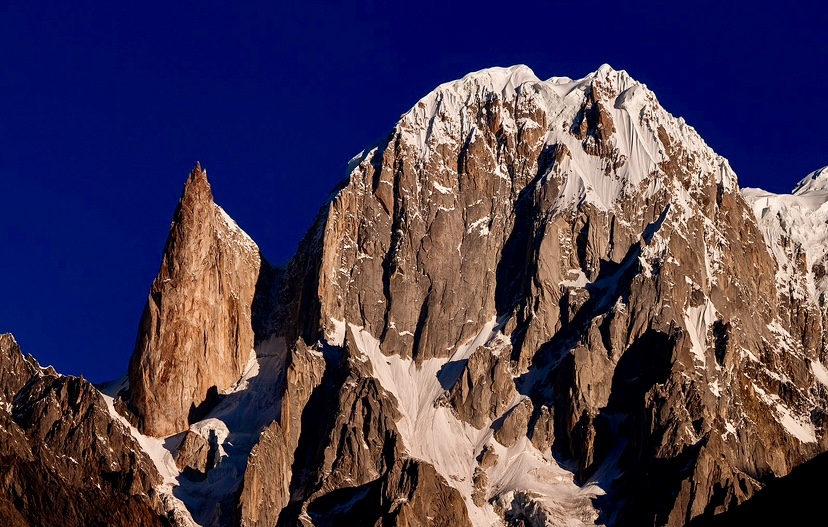
Bublimotin (Ladyfinger) and Ultar Sar. Photo: Fassifarooq
Ultar Sar has a subsidiary summit, Ultar II West, at 7,350m. There is also another lower Ultar peak to the northwest, Ultar Sar’s conjoined twin, 7,329m Bojohagur Duan Asir (confusingly also known as Ultar I, Ultar North, or Ultar West). Bojohagur Duan Asir has a southern subsidiary summit, which is 7,250m.
Ultar Sar’s impressive presence
Ultar Sar rises dramatically above the local terrain. The south flank reaches 5,300m above the Hunza River bending around it.
In his book No Place To Fall, Victor Saunders wrote about Ultar Sar: “The Karakoram Highway is five kilometers lower than the summit. There is no easy line, and any route to the summit from the south side would involve a climb of no less than 3,500m from bergschrund to final cornice.”
Saunders gave an excellent explanation of the topography of Ultar, describing it as the junction of three aretes.
“The highest of these comes from the northwest, from Bojohagur. This arete is probably over 7,300m all the way from Bojohagur to Ultar, a distance of a mile or so. The next arete forms another high-level ridge and runs out to the east. This feature maintains a crest of around 7,000m. Finally, there is a ridge falling more steeply due south.”
Bojohagur Duan Asir, the first ascent
In 1982, six Japanese climbers attempted the south side of Bojohagur Duan Asir from the Ultar Glacier. Bad weather stopped them just above the southwest col, and their highest point was only 5,957m. Rockfall hit three members of the team.
In the summer of 1984, Tsumeo Omae led another Japanese expedition to the peak. They approached from the west via the Hasanabad Glacier. This Japanese party eventually succeeded, topping out on July 28 via the southwest ridge.
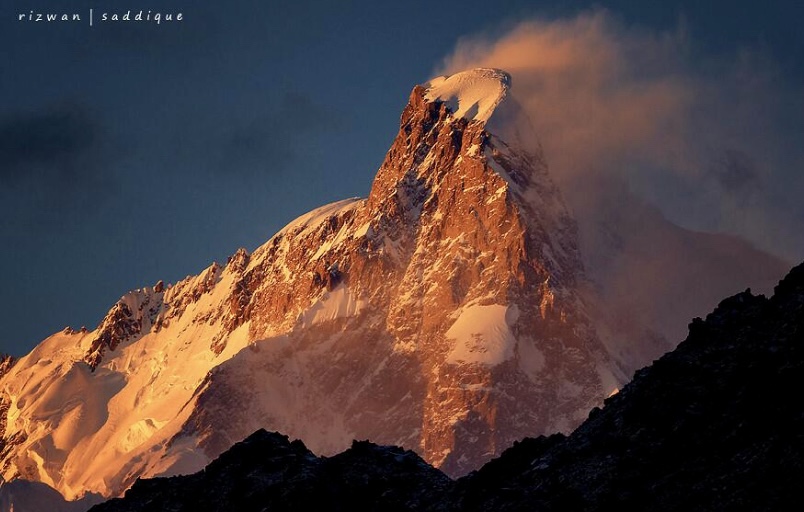
Ultar Sar. Photo: Rizwan Saddique
Attempts on Ultar Sar
Ultar Sar was one of the highest unclimbed mountains of the 1980s and ’90s. Naturally, it became a coveted peak. Between 1985 and 1996, more than 15 expeditions attempted the first ascent.
In 1985, Spanish climbers Kike de Pablos and Jose Luis Zuloaga scouted the southern side of Ultar and Bojohagur Duan Asir. According to them, there were too many falling rocks and dangerous seracs. Instead, they climbed a lesser peak southwest of Bojohagur Duan Asir.
In the following years, several teams made attempts, leading to many deaths.
In 1986, a Japanese-American party led by Toshio Narita attempted the north face from the Gulkin Glacier. Following a huge avalanche at Camp 1 (3,900m), they changed their route and tried the south face. Their highest point was 5,500m. This second route was also very dangerous, with falling rocks and plenty of ice.
Another Japanese party, led by renowned climber Tsuneo Hasegawa, attempted Ultar Sar in 1990. As they were ascending by the south ridge, the weather turned, and the climbers started to suffer from frostbite. They retreated from 7,020m.
Hasegawa, just the second person to solo climb the three major north faces of the Alps in winter (Ivano Ghirardini was the first), did not give up on Ultar Sar. But before Hasegawa could return to Ultar Sar, a British-American expedition attempted it in 1991. Victor Saunders and Steve Sustad made a three-day attempt via the southeast face-east ridge route but could not top out.
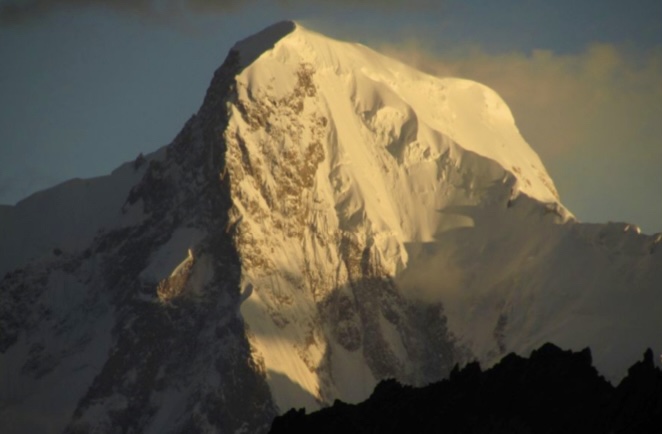
Ultar Sar from the east. Photo: Tim Miller and Bruce Normand
Death of Hasegawa
In the same year, Hasegawa and his team returned. Following the same plan as in 1990, they tried the south ridge. The team numbered nine Japanese climbers, including Masami Hasegawa, Hasegawa’s wife. The party was accompanied by Pakistani climber Nazir Sabir as their liaison officer.
They arrived at base camp in the late summer of 1991. On Sept. 15, they established Camp 2 at 5,450m on the south ridge, despite frequent rockfall and avalanches. After following the ridge to 5,900m, the climbers solved a steep icy section and pitched Camp 3 at 6,000m on October 3.
According to Masami Hasegawa’s report for the American Alpine Journal, three days later, Tsuneo Hasegawa and Kiyotaka Hoshino climbed to Camp 4 at 6,500m and returned to Camp 1 to rest. On Oct. 10, they started back up to Camp 3 but were caught in an avalanche and swept from 5,350m to 4,000m. Both men died, and the expedition was abandoned.
Hasegawa’s grave is at the Ultar Sar base camp.
Further attempts
Before its first ascent in 1996, there were several more attempts on Ultar Sar.
In 1993, a Norwegian party attempted the east face and south ridge, reaching 5,800m. In the same year, both a British-American team and a Japanese team also came away empty-handed. One member of the Japanese team died at 6,900m when a fixed rope broke.
In 1995, Toshio Narita and two other climbers attempted the Southeast Pillar, reaching 5,400m.
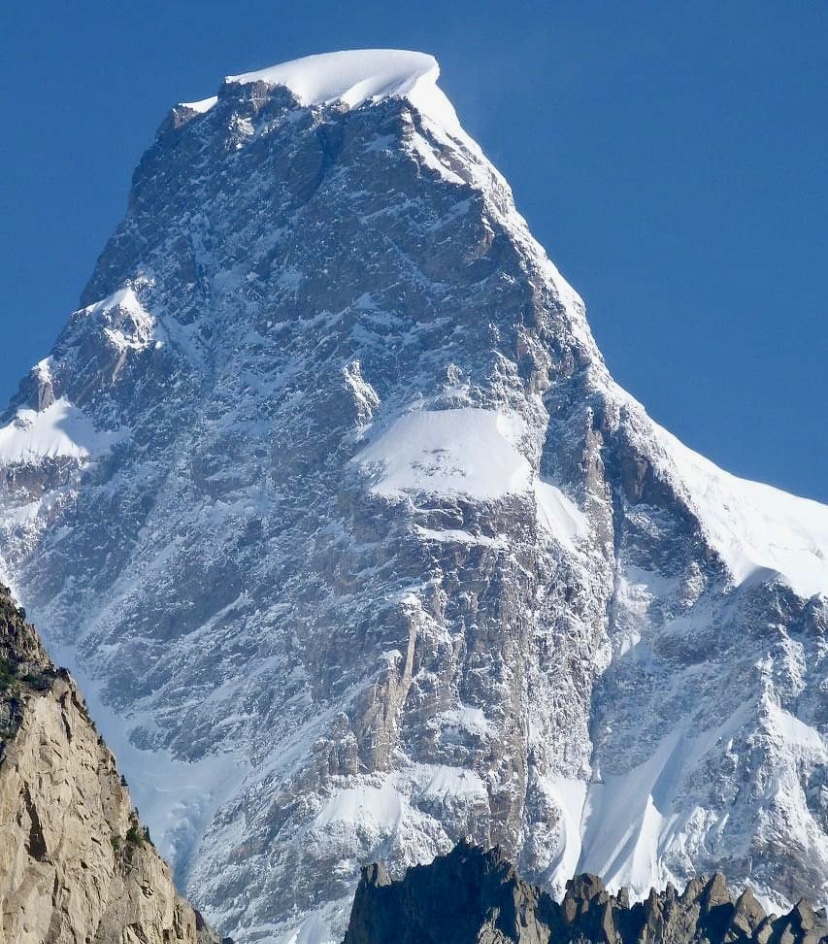
Ultar Sar. Photo: Christian Trommsdorff
The first ascent of Ultar Sar, triumph and tragedy
Finally, two separate Japanese teams succeeded in climbing Ultar Sar in July 1996.
On July 11, Akito Yamazaki (leader) and Kiyoshi Matsuoka from the Japan Alpine Club Tokai Expedition topped out after more than eight days on the mountain. They fixed only 450m of rope. The pair climbed in alpine style from the southwest side.
After summiting, they needed another eight days to descend in bad weather, utterly exhausted. During the descent, Yamazaki developed high-altitude sickness and died at Camp 1 on July 19. Matsuoka died one year later while attempting the nearby rock spire, Bublimotin Peak.
On July 31, another team topped out. Five members of the Japan Kathmandu Club Expedition led by Ken Takahashi summited via the south ridge. The team fixed 4,000m of ropes from 5,200m to 7,300m.
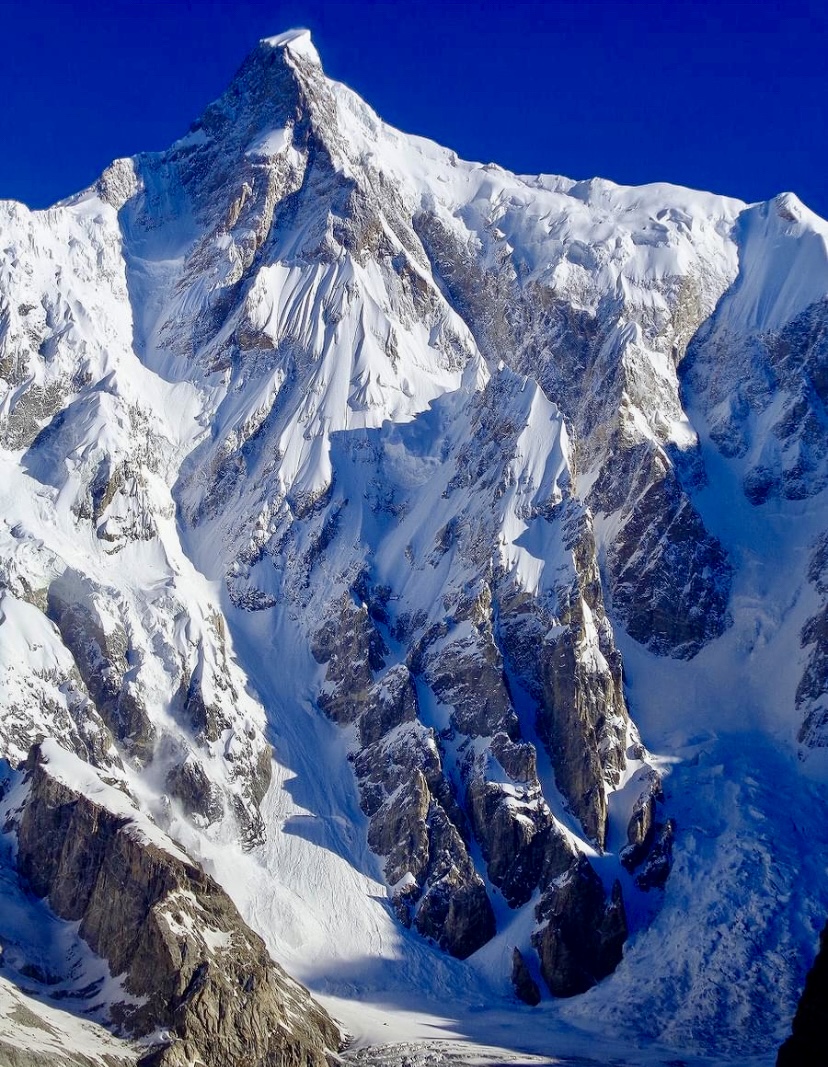
The southeast pillar of Ultar Sar. Photo: Christian Trommsdorff
Attempts on the southeast pillar
The unclimbed southeast pillar of Ultar Sar is one of the last great climbing challenges. It is called the Walker Spur of the Karakoram. Several strong teams have attempted it.
As mentioned, Toshio Narita and his team attempted the pillar in August 1992. They retreated from 5,400m. In 2000, Jerome Blanc Gras, Yannick Graziani, Erwin le Lann, and Here Qualizza planned a climb but could not even start on the pillar because of unsettled weather. In 2005, Graziani and Christian Trommsdorff reached 5,800m, about halfway up the pillar.
In 2011, Fumitaka Ichimura and Yusuke Sato made the best attempt. On their alpine-style push, they left base camp at 4,300m on Sept. 6. After a week, they reached 6,500m in worsening snow conditions. It was very hot; melting snow and running water caused problems. Sato later reported that they hoped to one day return for another try.

Ultar Sar. Photo: @aks_azeem
In the summer of 2018, Tim Miller, Bruce Normand, and Christian Huber also attempted the pillar. According to their report, the three climbers arrived at base camp on June 14. Until June 30, the weather was cold, wet, and unstable. During an eventual weather window, the climbers ascended to Camp 2 at 5,900m. There, four further days of snow pinned them down.
During the wait, a small avalanche buried their tent. Huber died, but Miller rescued Normand in the nick of time. A Pakistani Army helicopter picked up the two survivors.
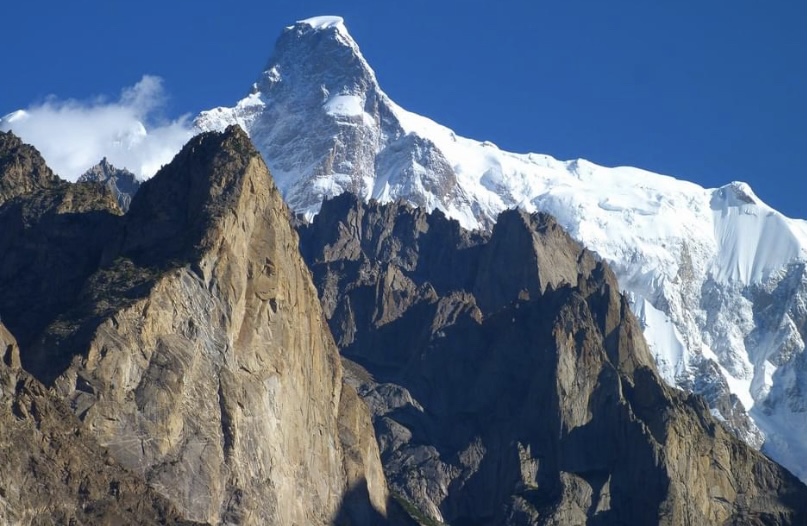
Ultar Sar. Photo: Christian Trommsdorff
A recent attempt
A few days ago, we reported on a recent attempt on the southeast pillar by Ethan Berman (who received the 2024 Cutting Edge Grant for this project), Sebastian Pelletti, and Maarten van Haeren. They did not succeed. The southeast pillar remains one of the most difficult unclimbed challenges in the Karakoram.
“With the route proper more than 3,100m tall, it makes the North Ridge of Latok I look small by comparison, and…it is sustained real climbing. [There is] very little simple slogging,” Colin Haley explained in 2007.
Besides the sheer scale of the route, the main difficulties are the mixed climbing from 6,500m to 6,900m and a rock barrier at 7,000m.
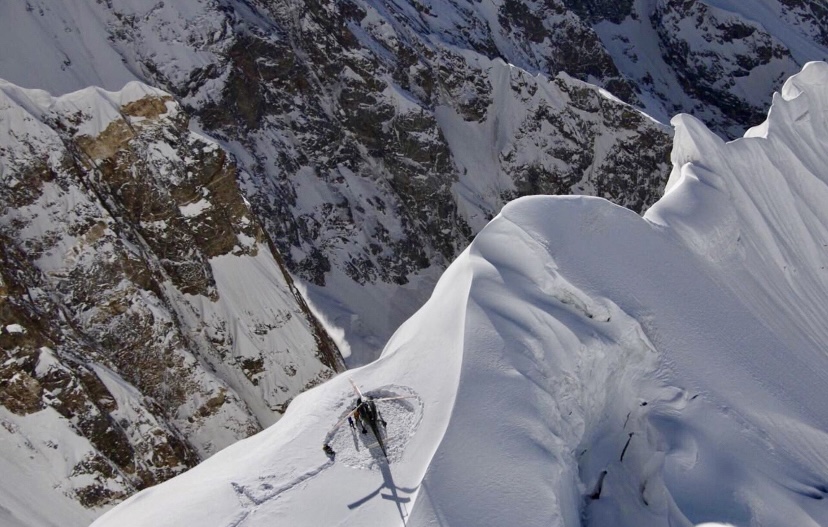
Helicopter rescue of Tim Miller and Bruce Normand on Ultar Sar in 2018. Photo: Pakistan Army


